« April 2013 |
Main
| June 2013 »
 May 30, 2013 | Arpeggios with Brian Oberlin; Herman's Rag
May 30, 2013 | Arpeggios with Brian Oberlin; Herman's Rag
For this week's Tips and Tricks article, we continues with guest columnist and Oregon clinician, Brian Oberlin. In addition to his Pacific Northwest teaching and playing schedule, Brian coordinates next week's River of the West Mandolin Camp, one of the finest mandolin workshops in the world.

Download PDF:

Listen: ( MIDI) MIDI)
Herman's Rag is a swinging fiddle tune from the great Herman Johnson. It's a good exercise in playing a tune with cyclical fifths. (VI7, II7, V7, I) Notice they are all dominant seventh chords. For me, the dominant seventh chord is a "shining beacon" for playing outside notes. In fact, these charts don't really get "outside" all that much but it's an introduction to getting nines, flat fives, flat nines, and the like.
Play the tune as written and notice the similarities between the positions in the melody. Use this to your advantage. Then get the Major chord arpeggios under your fingers and play that as written. The seventh chord arpeggios are just the icing on the cake.
Have fun with this one.
- Brian Oberlin
Download PDF:
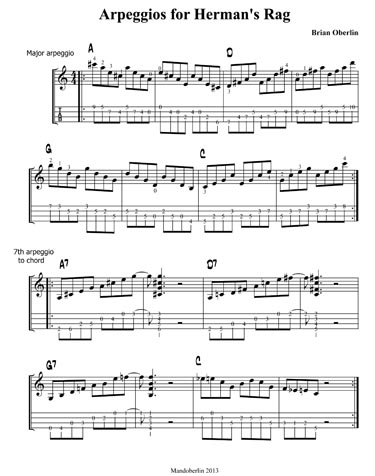
Listen: ( MIDI) MIDI)
Any questions or for the other verses, please email me. - Brian Oberlin
www.mandoberlin.com
Posted by Ted at 6:02 AM
 May 23, 2013 | 5-string Mandolin Chord Sets: Minor 'ii7b5 V7 i"
May 23, 2013 | 5-string Mandolin Chord Sets: Minor 'ii7b5 V7 i"
Last time we started our series on 5-string chords. We should remind you since we're focusing on the 3-note voicings in the lower three strings, these still work great for the mandola, tenor banjo or CGDA tenor guitar tuning. We gave you a PDF of chord pairs, the 'ii7b5 V7' combination for minor keys, and this time around we want to extend these into a full cadence, the 'ii7b5 V7 I' progression.
We spelled these pairs out in all 12 keys. This time around, we'll only do four, but it's an opportunity to do some transposition on your own, within a reasonable range of frets. If you have already downloaded last week's PDF, download it again. Our proofing committee missed a couple chords and we've since corrected them.
Download and print PDF:  5-string Mandolin Chord Pairs 'ii7b5 V7' 5-string Mandolin Chord Pairs 'ii7b5 V7'
The first pair (from the key of Bm7), we'll extend now to the tonic chord:
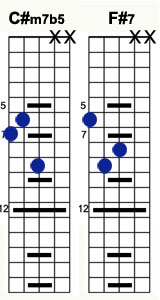
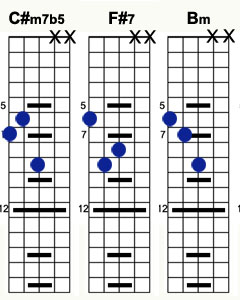
Lets's do the same with the next (for E minor):


Another way to voice this:


We've just given you three of our four ways to block out the Minor 'ii7b5 V7 I." Now we'll give all four on the PDF below.
Download and enjoy:  5-string Mandolin Chord Sets: Minor 'ii7b5 V7 i" 5-string Mandolin Chord Sets: Minor 'ii7b5 V7 i"
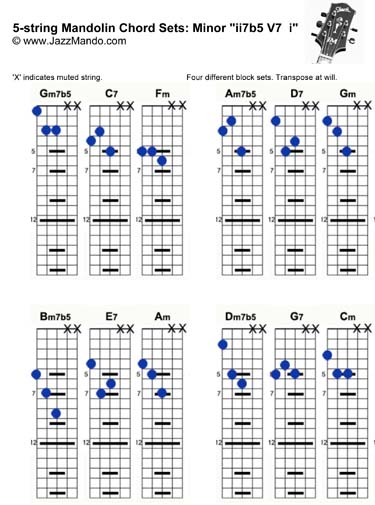
Free 5-string chord template PDF
Vamps. Minor modal
ii7b5 V7 i Minor Patterns
5-string chord pairs: 'm7b5 V7'
Applying minor chord blocks--Black Orpheus
Posted by Ted at 11:10 AM
 May 16, 2013 | 5-string chord pairs: 'm7b5 V7'
May 16, 2013 | 5-string chord pairs: 'm7b5 V7'
This summer we want to start introducing some 5-string chord combinations. Now wait, before you start saying, "Hey, I don't even own a 5-string," hear us out. We've spent much of the last year looking at 3-note chords and note the transposable nature of this approach, being able to move them up and down the fretboard, so why not move them down a string?
Even if you don't have a 5-string, you might have a mandola, and since we're focusing on the lowest three strings, you'll also be able to apply these concepts to tenor banjo and octave mandolin (tuned CGDA). The strategy will be chord relationships--pairs and trios of tasty chords that can be transported around, so if nothing else, ignore the chord labels and just see how they move from one to the next.
We're also going to do something a bit counter-intuitive and start with the hardest first and work our way back. This week we're going to look at pairs of the 'ii7b5 V7' chords that set up every minor chord. All twelve of them.
We'll give you blocks of 3-note chords based on the lowest three strings of CGDAE tuning. It may start to make more sense with each lesson, but for now, just play the chords as they are written out. There are only three combinations used in the twelve keys.
Just three!
Purchase information: JazzMando 3-note Mandolin "Playing Cards"

In our 4-string playing cards (see above), we offer a 'ii7b5 V7 I' set that shows four ways to play the progression. It's kind of foreign to the folk ear, not so much the simple tonic minor 'i' chord, but the two that go before it. We'll take on of the grips and place it in the lowest strings of the 5-string starting in the key of B minor
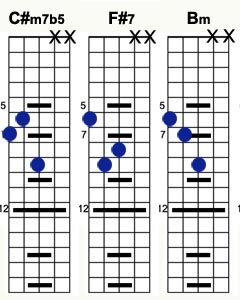
If we just focus on the first two notes of the pattern, we can develop skills that hone both ear and finger.

We have a one-page PDF that steers you through all twelve keys of the progression. Your mission is to play through these, but take your time and work them in prayers. Play the first chord four times before the second chord four times. Don't move on until you've done this or they've become comfortable to you. Again, we've only used three variations of these so you'll start seeing the patterns repeat right away.
Download and print PDF: 5-string Mandolin Chord Pairs 'ii7b5 V7'
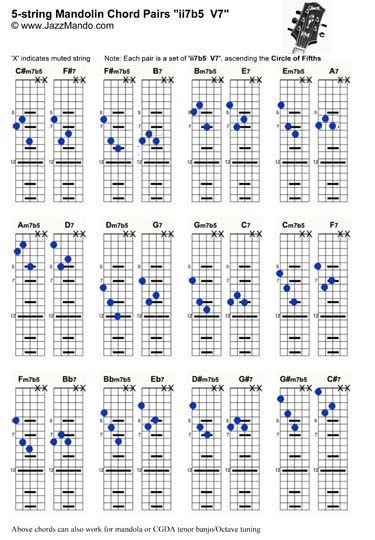
Did you notice once you've finished the last pair, you can start from the beginning and move successively through the Circle of 5ths again?
Take your time with these. Again, if you just have an 8- or 4-string, you can still glean a useful pattern here.
Stay tuned; we'll be covering some more basic chord grips for the 5-string soon.
Free 5-string chord template PDF
Vamps. Minor modal
ii7b5 V7 i Minor Patterns
m7b5 Chords
Applying minor chord blocks--Black Orpheus
Posted by Ted at 8:42 PM
 May 9, 2013 | Best of JM: Fourthness and Purple
May 9, 2013 | Best of JM: Fourthness and Purple
Enjoy the popular archive material below.
From August 2, 2007 | Fourthness and Purple

Music is such a subjective thing. The combination of art and science blends worlds of aesthetic intangibles with harsh concrete science, bringing listener and performer together in ways neither can control, predict, or imagine. The way the sense of hearing engages the mind is not unlike the other four senses; based on cumulative personal experience and familiarity, sometimes studied, more often subconscious.
Consider the antiseptic smell of a hospital. Most folks are conditioned to be uncomfortable around this, past unpleasant experiences condition the nose to warn the brain of potential discomfort, yet to a rescued jungle wanderer, this smell of civilization might instill an emotional state of sanctuary. The sound of a thunderstrom can be terrifying to a Sheltie puppy, but to a drought-stricken farmer, it's the voice of angels. Commercial graphic artists tell us a smooth Reflex Blue will induce calm to the reader, Cardinal Red will stimulate both attention and alarm. The senses respond culturally in somewhat predictable ways, but as individuals, often based on past experiences out of extremely personal histories.
Music and sound for the studied musician may mean significantly more than to the novice. Knowledge of theory involves the brick and mortar of harmonic and melodic structure, but this is mere intellect. How the aesthetic, the intuitive responds is every much as significant, and we can't afford to be eggheads about our theory. Ultimately, it's still a tool to not only deeper understanding, but a path to a higher level artistic experience. If done properly, in performances it can bring our audience along with us.
Chicago multi-instrumentalist and jazz mandolin pioneer, Don Stiernberg tells of his emotional response to chords and modes. Each chord extension may have a mood-inducing impact, a happy sound, a sad, an invigorating, and in his own mind, he experiences the music more passionately so. Certainly, he knows the theory, but that doesn't distract him from the aesthetic experience.
Berklee Professor John McGann quips, "Theory only seems like rocket science when you don't know it. Once you understand it, it's more like plumbing!" The truth is, we don't need to know plumbing just to enjoy a cool glass of tap water, but it's sure nice to have some basic knowledge of water pressure when maintaining a lawn or fixing a noisy toilet. His point is well-taken in that rocket science isn't something we all have access to, but plumbing is something we use (and enjoy) everyday; it's this experience that makes it relevant.
Have you ever pondered your own emotions stimulated by certain chords? Certainly, most will hear the stability of an open 5th or an octave. A three note major triad (C E G) is likely a "happier" sound than minor triad (C Eb G). Pondering more complex chords like major 7ths, impressions will be more subjective and individual. Certainly this harmonic vocabulary is more "peaceful" to the 21st century ear than use in past history. The contemprary blues musician will argue there is nothing more exciting than a flatted 5th note; a Medieval Gregorian monk would go out of his way to avoid this interval for fear of spiritual heresy.
It's all about context.
Let's offer some suggestions, but bear in mind, this is YOUR personal journey. We've talked about the "pull" of 4ths and 7ths. In practicing the FFcP scales think not only about which finger plays the 4th note of the scale, but add this interactive dimension of perception as you drill. In 1st FFcP, the 4th note is in the 4th finger, momentarily stopped in time does your ear (and finger) sense the restlessness? Do you experience the "fourthness? As you hit the 3rd note with your 3rd finger, is their a defining sensibility of majorness or minornesss? Do you enjoy a state of "thirdness." Can you duplicate this in 2nd FFcP and the other two fingerings?
In the early days of discovering the mandolin, when your playing was built on open strings as your home base, did these notes imbibe a feeling of stability, physically and aurally? How about emotionally? There's no reason you can' carry this sensation or experience into the other fingers AND expand characters and personalities to the other fingers. You really get beyond the mechanics of playing when you do this and experience true art even just running through scales and exercises.
What does that major 6th interval do for you? Is it happy, precocious, restless? How about the minor 7th? Is it consonant, rebellious... dare we get existential and say "purple?" There is no one single answer, and only YOUR answer as a unique artist and musician.
Experience in your practice routine, the art in the little things like this, and as you grow more deeply, the complex aspects of playing will become an even greater personal aesthetic journey.
Further:
Compose yourself. Story Arcs.
Forsaking the notes for the music.
Ensemble Sensitivity: Corps playing.
Building off silence.
Posted by Ted at 6:34 AM
 May 2, 2013 | Best of JM: Building off silence
May 2, 2013 | Best of JM: Building off silence
Enjoy the popular archive material below.
From May 8, 2008 | Building off silence
When we think of building phrases and intensity, we usually focus on where we are going. Higher, faster, louder, thicker texture, are all directions we can go, but part of the neglected elements are where we start. Simply, silence...
Think of an ice cream sundae. If you piled 100 cherries on top of the ice cream, butterscotch, chocolate, and couldn't even see the whipped cream top any more, it wouldn't be the same experience as one, two, or three cherries placed strategically on the top. You probably wouldn't enjoy the subtleties of the experience, the crunchy texture of nuts on the teeth, the cool ice cream on the palette of the tongue, the contrasting flavors in the swirl of butterscotch and chocolate at the roof of your mouth. Undoubtedly, you'd get sick of cherries, too.
Extreme soloing can be the same nauseating experience, and as a good ensemble player, you need to be sensitive to this dynamic as well. There's a time to comp intensely, and a time to lay back, and your contributions to the group will by dynamically better (pun intended) and appreciated. Let's ponder the ways to start.

Silence. This is a no-brainer, but many players feel they aren't contributing if they aren't making some kind of noise all the time. This couldn't be farther from the truth. Laying out at the beginning of a song, pulling back on a chorus, letting someone else be featured, offers the listener much more variety of texture. Not every bite of an ice cream sundae has to have nuts in it; after a few spoonfuls without nuts, they taste even better. Electric Mandolin pioneer Michael Lampert rarely if ever, even comps behind a soloist. If you're surrounded by great rhythm players, not only is it unnecessary, you also risk stepping on others' toes with too much rhythmic or textural complexity.
Single notes. Ever just played a consistent rhythmic pattern on a single note as background? If it's the right note (tonic, dominant), it can be quite effective. Kick it up a notch by playing it in octaves. You don't have to be complex to be interesting!
Short melodic phrases. This doesn't even have to be the "call and response" of antecedent/consequent phrases, but you can weave very slow melodies in the background, as long as you yield to the "right of way" of the soloist. Don't showboat, though. Simply play chord-rich elements melodically and slowly.
Parallel Two-note melodies. Playing intervals in 3rds and 6ths on adjacent strings is one of the coolest capabilities of the mandolin. Try this in slow quarter note and half note runs. You can be laying down the harmonic structure without risking "busy-ness."
Don Stiernberg is one of the best players to listen to for how to use silence (and simplicity). He has a gift for reeling you in with digestible bite-size chunks of savory melody, well-baked and spaced, then wham! Out of nowhere comes a blistering pyrotechnical lick that disappears as quickly as it's stated. It's always a treat to listen to what he does with the mandolin. Consider a purchase of all of his CDs an investment in tuition in the College of Tasty Jazz Mandolin.
Further:
Plays Well With Others...
Ensemble Sensitivity: Corps playing
Playing with a drummer
Building off silence
Posted by Ted at 8:00 AM

Disclaimer: In the 'Information Age' of the 21st Century,
any fool with a computer, a modem, and an idea can
become a self-professed 'expert." This site does not
come equipped with 'discernment.'
|



